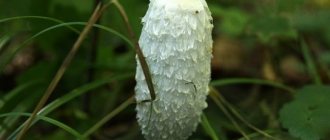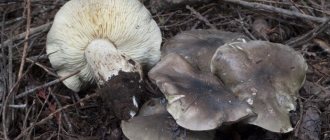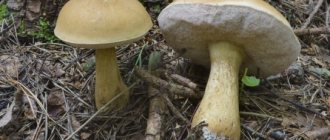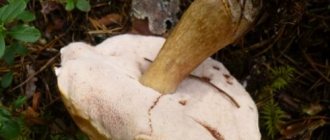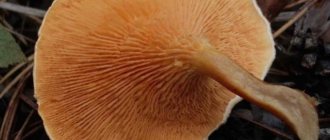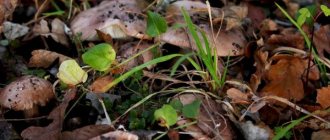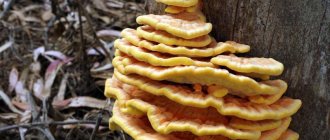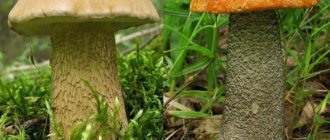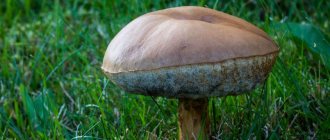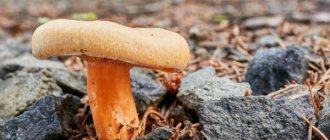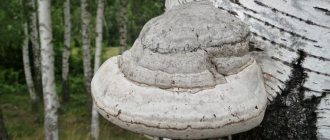Coprinus, or dung beetle from the Champignon family, is a conditionally edible mushroom and has about 25 varieties. Translated from Greek, "kopros" means "manure". Due to its ability to grow in manure, this representative of the fungal world is called the dung mushroom. Such species are scientifically called coprophiles. Most varieties are toxic and are not used in cooking.
However, there are several representatives that are classified as conditionally edible. The most popular varieties are white and gray. With proper heat treatment they acquire a pleasant characteristic taste. The development is very rapid - from the moment of appearance to complete dissolution, 3 hours pass. This species has long been used in writing: after maturation, the dung beetle turns into ink - hence the synonym “inky”.
Description of the mushroom
The Latin name Coprinus combines a whole genus of mushrooms belonging to the Agaricaceae family, which also includes the well-known champignons and slightly less, but also recognizable puffballs and “umbrellas”.
Did you know? Mycological scientists who study mushrooms number from 100 thousand to (according to some estimates) 1.5 million species.
To describe any mushroom, two parameters are traditionally used - appearance and growing conditions (place, time, etc.), since it is these characteristics in combination that help to accurately recognize and identify a particular forest find.
What does it look like
In appearance, Coprinus bear little resemblance to noble mushrooms and are more like toadstools.
The distinctive features of the representatives of the genus are as follows:
| hat | The shape is oval-convex (bell-shaped) or conical, very rarely flat, almost always remains closed. The surface of many species is covered with scaly growths. The bottom layer is plate type. The inside of the cap of young mushrooms is white, but as it matures it quickly turns black. |
| Leg | Cylindrical, smooth, long and thin, hollow inside, easy to crumble and break |
| Pulp | Fibrous and thin-bodied (not fleshy), more fibers in the leg |
Where does it grow
Coprinus received its dissonant popular name not because of its special smell, but due to the characteristics of its growth. This species belongs to saprotrophs, that is, organisms whose nutrition consists of dead organic matter. In nature, they play an important role in helping plant residues turn into fertile soil. Coprinus, like other coprophilous mushrooms, appear in heaps of manure or in soils oversaturated with organic matter - humus, compost, humus.
In addition, rotting tree stumps, as well as garbage heaps in forest plantations, parks and gardens, are a favorable environment for dung beetles. Another typical habitat for the species is meadows where livestock graze. The first specimens can be seen in mid-summer (some species even in spring), and the last ones disappear before the onset of frost.
Edible or not
There are no truly poisonous representatives of the Coprinus genus, just as there are no true delicacies among them. The morphological characteristics of dung beetles allow us to classify most of them as inedible or conditionally edible. According to generally accepted terminology, this classification means that you cannot be poisoned by the mushroom, but its taste characteristics leave much to be desired. In relation to Coprinus, the reason for this assessment is the small size of the mushroom and its too thin texture: it is inconvenient to prepare such a product, it cannot be cooked for a long time due to the complete loss of shape.
Learn how to cook mushrooms in the oven.
But the main “problem” of Koprinus is its fragility, and this applies to both the growing and already cut mushroom. The fact is that approximately two days after the start of formation in the tissues of Coprinus, a unique program of “self-destruction” is launched, which in the scientific world is called autolysis (from the ancient Greek “αὐτός” - itself and “λύσις” - to decompose). As soon as the autolysis process begins, the dung beetle begins to look so unappetizing that there can be no talk of eating it.
It’s easy to verify this by finding the corresponding photos on the Internet, or even better, videos shot in accelerated mode: starting from the cap and then throughout its entire area, the mushroom seems to melt, flowing to the ground with dark ink drops until it completely turns into a tar-like substance. puddle. For this reason, the dung beetle, by the way, is sometimes called the ink mushroom. The same thing happens with Coprinus if, after collecting, you put it in the refrigerator for at least a day or simply leave it in a basket, so you need to prepare dung beetles immediately upon returning from the forest.
Important! One of the most respected international mycological classifiers, the Ainsworth and Bisbee Dictionary of Fungi, included 10 species in the genus Coprinus in its 2008 edition, and in 2010 this number increased to 25.
Freezing is also not possible. Speaking about the conditional edibility of dung beetle, it should be understood that not any “harvest” is suitable for consumption, but only one that was collected in an environmentally friendly place. Mushrooms grown on a garbage heap, regardless of their species, should not be eaten: their pulp, like a sponge, absorbs all the industrial waste that surrounded the mushroom during its development - both in the air and in the soil.
Characteristics
The shape of the mushrooms is capped. Moreover, they have an elongated central leg. The hat has a convex bell-shaped shape; it almost never opens flat. The surface of the cap is smooth, bare, covered with a coating in the form of flakes or scales. The pulp is so thin that, due to its absence, most types of mushroom are considered inedible.
Dung beetle is a mushroom with an elongated, cylindrical stalk. It is often hollow and smooth with fibrous flesh. Wide, frequent and thin plates are white at an early age, then turn pink (yellow), but in older mushrooms they turn black or brown.
The fruiting season for Coprinus is May-October.
hat
The cap of dung beetles is bell-shaped, conical or convex, sometimes in mature mushrooms it opens to flat. The surface can be bare or scaly, with flakes.
Pulp
The flesh is thin-fleshy in the cap, sometimes there is very little or practically none, in the stem the pulp is fibrous.
The surface of the legs of dung beetles is smooth, the shape is cylindrical, elongated, and hollow inside.
Varieties and lookalikes
The species composition of the genus Coprinus is constantly being revised. Some species, originally classified as dung beetles, were later separated into separate genera or even transferred to other families; others are still under debate.
Of course, there is no need to study and memorize all varieties of dung beetles; it is enough to be able to recognize only the most frequently encountered ones. In addition, as with other mushrooms, in this case it is very important to know what Coprinus can be confused with, paying, of course, special attention to its inedible and poisonous counterparts.
White dung beetle
Almost the only species of dung beetle that is clearly classified as edible is Coprinus comatus. The appearance of this mushroom is so characteristic that it is almost impossible to confuse it with any dangerous double.
You will be interested to know how to deliciously prepare pureed porcini mushroom soup.
Features:
- height 5–20 cm;
- the cap is ovoid (in young specimens - in the form of a spindle), always closed, snow-white in color with possible shades of grayish or beige, in the upper part it is smooth and darker, the rest of the area is decorated with flake-like scales (because of this, the second name of the mushroom is shaggy dung beetle) ;
- the leg is white, thin (up to 2 cm) and long (up to 30 cm);
- pleasant “edible” smell;
- very fast growth (4-5 cm per day);
- collection season - from late spring to mid-autumn;
- place of growth - roadsides, gardens, vegetable gardens, fields, although it is also found in the forest.
It is worth saying that there is another species of dung beetles with a similar name - Coprinus niveus. It is also white, but its cap is smooth and seems to be dusted with flour, which is easily washed off. This species is classified as inedible.
Video: white dung beetle
Gray dung beetle
It is to the gray dung beetle (Coprinus atramentarius) that the name “ink mushroom” is most suitable.
It is characterized by the following features:
- the diameter of the cap is 3–7 cm, the shape changes as it grows from ovoid to bell-shaped;
- the color of the cap is grayish-brown, the top is darker;
- thin strips diverge from the top of the cap to the edges, which in adult mushrooms turn into cracks, after which the edges of the cap between these cracks rise upward;
- plates numerous, wide; in young mushrooms they are white, in adults they are brown, and after the start of autolysis they are black;
- stem height 12–16 cm, thickness 1 cm, soft, watery structure, off-white color along the entire length, and with red-brown splashes in the lower part;
- the aroma is pleasant;
- shelf life is minimal: after collection, complete autolysis occurs in just a few hours.
Coprinus atramentarius is classified as a conditionally edible mushroom.
Video: gray dung beetle
Dung beetle romagnesi
Another common species, Coprinopsis romagnesiana, is very similar to the gray dung beetle. Its main difference is its more pronounced “shaggyness” (in this quality, Romagnesi is similar to white dung beetle). The scales have a dark brown color with a possible tint towards orange or brown. In young mushrooms, the “fringe” fits tightly to the cap, but as it matures it becomes more fluffy at the edges. The leg is white, with slight hairiness and, in some cases, with a seal in the lower part.
Check out the recipe for stewed potatoes with mushrooms.
The average size of the mushroom is 6–12 cm in height, the thickness of the stem is up to 1.5 cm. Another feature by which Coprinopsis romagnesiana can be distinguished from the gray dung beetle is the almost complete absence of smell (as well as taste). The fruiting period usually occurs in spring and summer, but there are repeated periods of appearance of these mushrooms in the second half of autumn. Like the gray dung beetle, Coprinus romagnesi is conditionally edible.
Dung beetle lookalikes
In addition to those mentioned above, in the literature you can find descriptions and photographs of the following varieties of dung beetle and its counterparts:
| Russian name | Latin name | Consumer properties (according to various sources) |
| ordinary, or ash gray | coprinus cinereus | conditionally edible |
| flickering | coprinus micaceus | conditionally edible / inedible |
| home | coprinus domesticus | inedible |
| absent-minded | coprinellus disseminatus | inedible |
| narcotic | coprinus narcoticus | inedible |
| fluffy or mossy | coprinopsis lagopus | inedible |
| folded | parasola plicatilis | inedible |
| resinous, or magpie, or motley | coprinopsis picacea | inedible |
| willow | coprinellus truncorum | inedible/poisonous |
How to recognize white dung beetle - signs and habitats
Probably everyone has seen this mushroom. To do this, you don’t need to go into the forest. Dung beetles grow in large quantities even in cities. It happens that they even come out in flower beds. As their name suggests, they grow in well-fertilized soils. These can be compost heaps, decomposed garbage dumps (of organic origin), pasture areas for cattle and poultry, in the forest near rotten trees, in parks on decomposed leaves. The first mushrooms appear at the beginning of summer and grow until autumn frosts.
The appearance of the mushroom is elongated and elongated with a bell-shaped cap. It can reach fifteen centimeters in height. The leg is straight, hollow inside, and has a thickening at the base. It has a membranous ring at the top. The cap is ovoid, with scales and a bell. The color is white, the top of the cap has an ocher tint. The mushroom does not worm.
How to correctly identify dung beetle - watch the video story. The mushroom picker clearly shows where and how the mushroom grows and how edible it is:
Growing
Despite the rather low taste characteristics of dung beetles, some lovers strive to grow them on their plots, along with vegetables and fruits. Fortunately, artificial breeding of Coprinus is not that difficult.
For this it is enough:
- prepare in advance a bed well fertilized with organic matter , located in a shaded place - even a rotting compost pit or land left fallow, enriched with fresh manure, will do (many crops do not tolerate this fertilizer well, so it is placed in the soil a year or even two before planting );
- look for a suitable mycelium in a forest, field or planting , then in mid-autumn dig up a fragment of it along with the underground part and carefully move it to a new place, burying it 4–6 cm into the ground;
- If the mycelium takes root, you can harvest next summer .
Coprinus can also be grown indoors. To do this, you can use boxes, bags or boxes filled with organic matter - manure or humus mixed with straw, fallen leaves or plant tops. The mycelium is transferred to such a substrate, covered with fertile soil, and on top with a layer of thick cardboard to protect from light.
Important! The composition of artificially grown Coprinus is poorer compared to mushrooms growing in the wild. In particular, it has been established that the “domestic” dung beetle does not contain two important amino acids - histidine (essential) and tyrosine (essential).
The prepared containers must be watered abundantly and the optimal temperature regime must be monitored (the air in the room should not warm up above +30°C). Mushroom growth begins quite quickly after planting; after a month or even less, you can begin the first collection. During the season, experienced farmers harvest such a crop several times.
Notes
- Annotated list of rare and endangered species of invertebrate animals, specially protected within Russia // 2003* Russia* Red List of Specially Protected Rare and Endangered Animals and Plants. (2nd issue). Part 2. Invertebrate animals (Red Book Bulletin, 2/2004 (2008)) / rep. ed. V. E. Prisyazhnyuk. - M.: Red Book Laboratory of the All-Russian Research Institute for Nature Conservation, 2004 (2008). - P. 189. - 512 p. — ISBN 978-5-9243-0158-7 Full text
- ↑ 1 2 Striganova B. R., Zakharov A. A.
Five-language dictionary of animal names: Insects (Latin-Russian-English-German-French) / Ed. Doctor of Biology sciences, prof. B. R. Striganova. - M.: RUSSO, 2000. - P. 116. - 1060 copies. — ISBN 5-88721-162-8. - Key to insects of the European part of the USSR. T. II. Coleoptera and fanptera. / under general ed. Corresponding member G. Ya. Bey-Bienko. - M.-L.: "Science", 1965. - P. 166-208. — 668 p. — (Key guides to the fauna of the USSR, published by the Zoological Institute of the USSR Academy of Sciences; issue 89.). — 5700 copies.
| This is a draft article on entomology. You can help the project by adding to it. |
Benefits of mushroom
Oddly enough, dung beetle can be considered a useful product.
Its fragile pulp contains a number of valuable nutrients, in particular:
- vitamins - thiamine (B1), riboflavin (B2), choline (B4), pantothenic acid (B5), folic acid (B9), ascorbic acid (C), tocopherol and tocotrienol (E), phylloquinone (K1), ergocalciferol (D2 ); nicotinic acid (PP);
- minerals - iron, calcium, potassium, magnesium, zinc, sodium, selenium, etc.;
- amino acids - both non-essential (9) and essential (8);
- simple and complex saccharides - glucose, fructose, polioses;
- enzymes - maltase, tyrosinase, trypsin;
- fatty acids, including the most valuable ones - polyunsaturated ones.
Important! The most valuable substance betaine, which is a derivative of the amino acid glycine, was found in the pulp of dung beetle. As established by modern science, it plays an important role in removing toxins from the body, breaking down fats, stimulating appetite, gaining muscle mass and protecting it from destruction.
- Thanks to this composition, Coprinus has the following beneficial properties:
- improves digestion and metabolism;
- has a choleretic and fat-burning effect;
- blocks inflammatory processes;
- reduces blood pressure and blood sugar levels;
- is a natural antioxidant;
- stops bleeding of any nature;
- exhibits bactericidal and anticarcinogenic (antitumor) qualities.
Compound
The main substance of the dung mushroom is coprinus. When alcohol interacts with this substance, a toxic reaction begins to occur in the body. Acetaldehyde, a substance toxic to the body, is formed. When this substance accumulates in the body, it causes:
- the appearance of cyanosis throughout the body;
- tachycardia;
- dizziness;
- constant vomiting;
- heartburn;
- semi-fainting state;
- diarrhea;
- intestinal colic.
After taking coprinus, a person develops a persistent aversion to alcohol, even to low-alcohol drinks.
In addition to coprinus, dung beetle contains other beneficial components. It contains carbohydrates, fiber, proteins, B vitamins, macro- and microelements. amino acids.
Chemical elements in the dung beetle include: nicotinic acid, vitamins D1, B, E, K1, E, amino acids, iron, glucose, phosphorus, fructose, calcium and other beneficial substances that the body needs.
Coprinus is rich in protein (up to 49 g per 100 g of raw materials), and it also contains a minimal amount of fat - no more than 5 g per 100 g. The mushroom is low in calories. Calorie content is 16–22 kcal depending on the type of dung beetle.
Due to the content of the above components in coprinus, this mushroom has a positive effect on the cardiovascular and digestive systems. It lowers sugar levels and helps with joint diseases.
After numerous studies, it was confirmed that this mushroom contains a special substance that destroys malignant tumors. There is evidence that dung beetle treatment helped prevent the development of aggressive sarcoma.
Use in cooking
There are two types of dung beetle used in cooking: white and, to a lesser extent, gray. However, Europeans also eat dung beetle with great pleasure; moreover, in the Czech Republic, France, Finland and some other countries, this mushroom is served in expensive restaurants as a delicacy. Only young specimens are suitable for consumption: after the plates begin to darken, the mushroom is thrown away. Ideally, the dung beetle should be collected within two days after the cap appears above the ground and cooked no later than 1.5–2 hours later.
Experts recommend cooking only the caps, since the hollow stem inside contains practically no edible pulp. Due to the peculiarities of their structure, Coprinus cannot be combined with other mushrooms. Regardless of the method of preparation (usually frying, although pickling, stewing and adding to soups are also allowed), dung beetles should first be boiled for 15 minutes, after which the water used must be drained.
Did you know? The most expensive mushroom in the world is the white truffle. There is a known case when for just one copy (though it weighed 1200 g), the seller managed to earn $150,000.
This way ensures that the product gets rid of harmful impurities and neutralizes possible toxins. It is possible to prepare dung beetle in the form of a semi-finished product only by drying. However, to block the process of self-destruction, the mushrooms must first be boiled, then fried, and only after that, in a fully prepared form, dried in a special device or in an oven.
First recipe
- Pour sunflower oil into a cauldron or frying pan and heat it over medium heat.
- We take the dung beetle mushroom, reviews of which can be seen in the article below, cut off its caps, pour them into a frying pan, add a little chopped onion and salt.
- Simmer the mushrooms over low heat, without adding water, as the dung beetle will release its own juice.
- Cook for about 50 minutes. Then the mushrooms can be eaten or added to soup.
Coprinus has a very subtle and pleasant taste and, when cooked, is a bit like champignons. People who do not plan to drink alcohol can eat mushrooms without any fear and in unlimited quantities.
- Place the pulp of finely chopped mushrooms in a large shallow frying pan.
- Fry over low heat until the water evaporates, stirring all the time.
- Dry the finished mass, then grind it into powder in a coffee grinder.
This powder is added to the drink or food of a person who drinks alcoholic beverages.
Application in medicine
Thanks to its unique chemical composition, Coprinus has found wide application not only in cooking, but also in medicine. At the same time, if white dung beetle is often eaten as food, then gray dung beetle is of much greater interest to doctors.
Another interesting area of medical use of gray and shimmering dung beetle is the treatment of alcoholism.
On its basis, drugs are prepared for treatment, including complex treatment, or prevention of such pathological conditions as:
- cardiovascular diseases, including hypertension;
- diseases of the joints and prostate gland;
- diabetes;
- hemorrhoids (hemostatic and analgesic effect);
- weakened immune system;
- bacterial infections, in particular those caused by staphylococci and clostridia (gas gangrene);
- bowel dysfunction (constipation);
- oncological diseases (breast, prostate, stomach cancer).
It turns out that coprine, which is present in these mushrooms and gives the name to the genus, when interacting with ethyl alcohol, causes very unpleasant symptoms in humans - from mild dizziness and nausea to hyperthermia and severe abdominal pain. This interesting property has long been successfully used to “code” chronic alcoholics: painful sensations once experienced are firmly associated in the patient’s psyche with drinking alcohol.
Did you know? For a long time, secret service workers and some high-ranking officials used special ink made from self-decomposed dung beetles to sign especially important documents. The unique composition of such ink and the fungal spores visible in it using special instruments completely eliminate the possibility of counterfeiting and falsification.
It should be noted that the side effect in question, as a rule, passes for a person without serious consequences and is mainly symptomatic. However, the combination of alcohol and coprine in the presence of diseases of the cardiovascular or respiratory systems, as well as problems with the kidneys or liver, can seriously aggravate the patient’s condition, so before treating alcoholism with such a folk remedy, you should definitely consult a doctor.
Video: powder against alcoholism
Species with medicinal properties for addiction
There are several types of coprinus mushrooms that will help overcome alcohol addiction:
- Gray is the best and most effective type of coprinus that fights alcoholism.
- Shimmering - the cap is yellow-brown, yellow-brown in color. It is also effective against alcohol, but has a less pronounced effect than gray.
- White - has a bell-shaped cap of beige or cream color. It can also be used against alcoholism, however, as a shimmery type, it is not as effective as the gray one.
Dung beetles do not treat alcohol addiction. They only form a negative attitude towards alcohol. As a result, a person’s desire to drink is suppressed.
Danger from the mushroom
Mushroom pickers should know that in the Coprinus genus there are separate species that can cause poisoning. A striking example is the willow dung beetle (Coprinellus truncorum). And although the likelihood of death in such cases is low, if the cooking technology is violated, excessive consumption or other unfavorable circumstances (childhood or old age, the presence of certain chronic diseases, etc.), serious health problems can arise. The best way to avoid this is to not eat such mushrooms.
Mushrooms from the genus Coprinus can be considered as a vivid example of how relative and subjective everything in this world is. Unpresentable in appearance, growing in manure heaps, garbage pits and city dumps, almost instantly turning into an ink puddle, they are not only considered a real delicacy in some European countries, but are also the object of targeted cultivation, including for subsequent sale.
And yet, the above does not mean that dung beetles can be collected anywhere and everywhere: although the majority of Coprinus do not contain highly toxic substances, you can be poisoned by them due to negative changes in the composition of the air and soil, to which mushrooms, especially those growing in urban areas, are affected. react sensitively.
Answers to common questions
Mushrooms are quite complex organisms, and often hazardous to health, so a lot of questions arise about their collection and use.
Are all mushrooms that grow on trees parasites?
No, there are varieties that have settled on an already sick, dying plant. They did not cause his death, and, on the contrary, in nature they play the role of orderlies, clearing the forest of rubble, turning trunks and stumps into humus.
How to remove a mushroom from a tree?
To use the mushroom itself, simply cut it close to the bark without damaging the attachment point. If we are talking about how to remove the parasite from the trunk, then in most cases this process is useless, since the fungus consists of a mushroom body and mycelium, that is, roots that are located in the trunk and it is impossible to remove them from there. Cutting off the fruiting body, unfortunately, will not cure the tree; perhaps it will just prolong its life a little.
Which tree mushrooms are the most dangerous in our area?
There are no particularly dangerous, deadly poisonous tree mushrooms in our latitudes, and there is no relationship between the “toxicity” of the mushroom and the type of tree. But this does not mean that all of them can be eaten. Many of them can cause health problems, especially if you consume too much of them.
Like all ordinary edible mushrooms, wood mushrooms are also useful in many ways and even tasty. The main thing is to study them so as not to make mistakes when collecting, as well as their preparation and processing features.
Among the huge number of representatives of the mushroom kingdom, mushrooms growing on trees are often found in forests. Among them there are popular and edible ones, for example, honey mushroom and oyster mushroom. And many are considered inedible parasites, which is not always true. They are quite diverse and interesting to study.
Interesting Facts
To treat alcoholism, dung beetle powder should be given to the patient during a period of heavy drinking, otherwise the result from consumption will be zero. Thus, severe poisoning is provoked, which develops aversion and persistent refusal of alcohol.
As they decay, the mushrooms produce a black slurry or pulp that was previously used as writing ink. It is impossible to fake them, since the spores remain on paper and are clearly distinguishable.
White dung beetle is a tasty edible mushroom that is important to collect only in environmentally friendly places. It is delicious boiled, fried and baked. In many countries it is considered a delicacy and is grown on an industrial scale.
Dung beetle is one of the edible mushrooms that should not be ignored. It is tasty, nutritious and can wean you off bad tendencies. The dung beetle has only one drawback: this mushroom is very similar to a toadstool.
Edibility
The white dung beetle (shaggy or white ink) causes a lot of controversy, because in different regions they look at it differently. Today it is considered conditionally edible. For example, in Russia and Belarus it is loved by mushroom pickers, in some Western countries it is considered poisonous and is refused to be eaten, and in the Czech Republic and Finland it is considered a delicacy.
Be that as it may, not a single examination has confirmed the presence of toxins dangerous to humans in the white dung beetle. In addition, the advantage of the mushroom is that it often grows in large groups. Therefore, when going to the forest during the season, it is impossible to return without a rich harvest.
Dung beetles are used for preparing first courses, fillings, snacks and canning. They are tasty both fried and boiled. Young mushrooms do not require pre-boiling, and some sources claim that they can even be eaten raw when young.
The crop should be processed a maximum of 2 hours after harvest, since the autolysis reaction is not inhibited even in frozen products.
Considering that the white dung beetle prefers anthropogenic places, it is better not to collect them there, since the fruiting body can absorb various toxic substances.
Operating principle
Mushrooms of the genus Coprinus contain chemical microelements that prevent the breakdown of alcohol. Coprine oxidizes ethanol, turning it into acetaldehyde. Even a small amount of it in the body leads to intoxication. Slowing metabolism is accompanied by a large number of side effects:
- Dizziness.
- Nausea.
- Diarrhea.
- Low pressure.
- Temperature increase.
- Stomach ache.
- Prolonged gag reflex.
- Constant thirst.
Often the patient does not suspect that he is taking coprinus. When mixed with food or drink, the substance begins to work in the body immediately. An alcoholic thinks that he is experiencing the consequences of binge drinking or alcohol poisoning.
